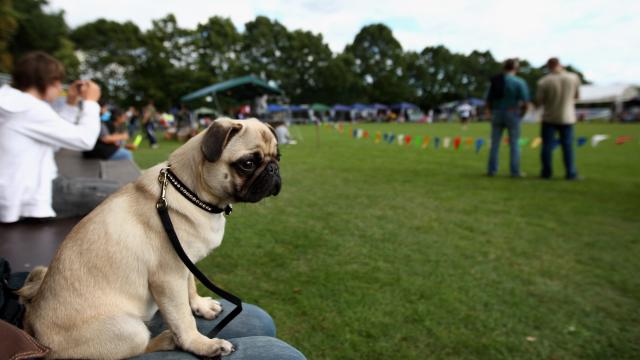If ever there was an animal that most exemplified a Shakespearean tragedy, it’d be the pug. The same features that have made them Instagram stars and one of the most popular dog breeds – their mushy cubed heads, bulging big eyes and never-ending folds – also underlie the multitude of health problems from which they suffer. A new study published this week in the BMJ suggests that the plights of pugdom are even worse than we thought.
Photo: Getty
Swedish researchers surveyed 550 dog owners with pugs who turned either one, five or eight years of age sometime between 2015 to 2016. The pugs were all registered in the Swedish Kennel Club. In addition to filling out either a paper or online questionnaire, the owners were also asked to send in short video clips of their pugs walking back and forth slowly on a leash, from different angles, including the side. These videos were analysed by two veterinary neurologists.
Of those who answered a question about their pet’s gait, nearly 80 per cent of the owners said their pugs had a perfectly normal walking stride. But 30 per cent also said their pugs displayed direct and indirect signs of an abnormal gait, such as avoiding certain surfaces such as asphalt; trouble jumping; and worn-down, bleeding nails and skin on the front side of their paws, presumably caused by dragging feet. Likewise, the neurologists judged that a third of the pugs in the analysed videos (59 in total) had trouble walking.
More worryingly, the study also found a bleak pattern among the 47 dogs who were euthanised during the study period.
“Although respiratory problems have been given a lot of attention – with reason! – not only in pugs but also in other brachycephalic (short-faced) breeds, this study showed that the single most common cause for death in pugs was actually an abnormal gait,” lead author Cecilia Rohdin, a veterinary neurologist and PhD student at the Swedish University of Agricultural Sciences, told me via email. In all, more than a quarter of deaths were tied to an abnormal gait. “This suggests that gait abnormalities are a more significant health problem than previously suggested, at least in published scientific literature,” she added.
Problems walking are known to be indicative of hidden neurological or skeletal problems. But because most of the afflicted pugs had trouble with their motor coordination, the culprit seems to be much more often neurological, the authors said. The pugs were less likely to show these signs the younger they were, but they became more common after the first year. Poorly walking pugs were also more likely to have trouble going to the bathroom properly.
Owners were less able to identify a poor gait than the researchers were, which might suggest they’re looking at their pugs through rose-coloured glasses. But Rohdin noted that many might think these more indirect signs are harmless, since they don’t seem to cause the pugs any noticeable suffering. Because the pugs’ worn down nails and paws were likely often caused by scuffing feet, though, that could also mean they have trouble perceiving sensations, another sign of neurological issues.
At this point, it isn’t clear what exactly it is about the pug’s body shape that seems to make them susceptible to these gait problems. Pugs are known to be at greater risk of certain brain disorders tied to a genetic cause, such as pug dog encephalitis.
“The anatomy of brachycephalic breeds, including the pug, makes them prone to specific health problems; some are ‘easy’ to understand, e.g. large exposed eyes make them prone to corneal ulcers (they ‘bump into things’); a short nose with stenosis of the nares that makes it difficult to breathe and thermoregulate,” Rohdin said. “If – and if so how – these gait abnormalities are associated with the conformation of the pug needs to be further studied.”
In light of these well-established problems, animal welfare groups have called for a ban of pugs and similar breeds in advertising, lest more people be encouraged to buy them and drive up demand. Vets in the UK have even pleaded with the public to stop buying them, saying their growing popularity has led to “increased animal suffering”.
For their part, Rohdin and her colleagues are agnostic about whether pugs should continue to be bred.
“My role as a researcher is to do research and not have an opinion. I meet a lot of pugs and their owners, I appreciate their adorable personality and I see how extremely dear they are to their owners,” she said. “We all, veterinarians, scientists, breeders, pug owners, must work together for sounder pugs in the future.”
Rohdin hopes that her and others’ research can help pinpoint the hereditary causes of pug-related problems, which might lead to ways we can someday genetically select for healthier dogs.
“In the meantime, the best you can do for your pug is to keep it lean and active,” she said. “Although obesity was not associated with gait abnormalities in the pug, it is considered a risk factor for brachycephalic airway syndrome and should be avoided.”
